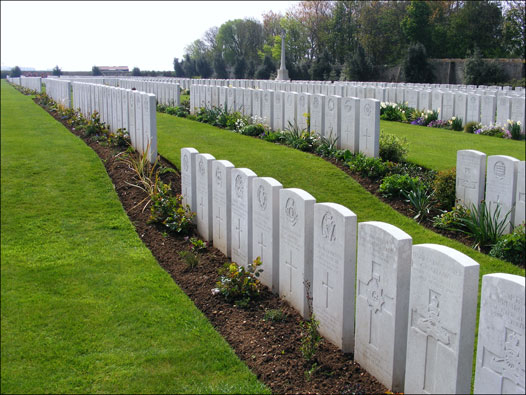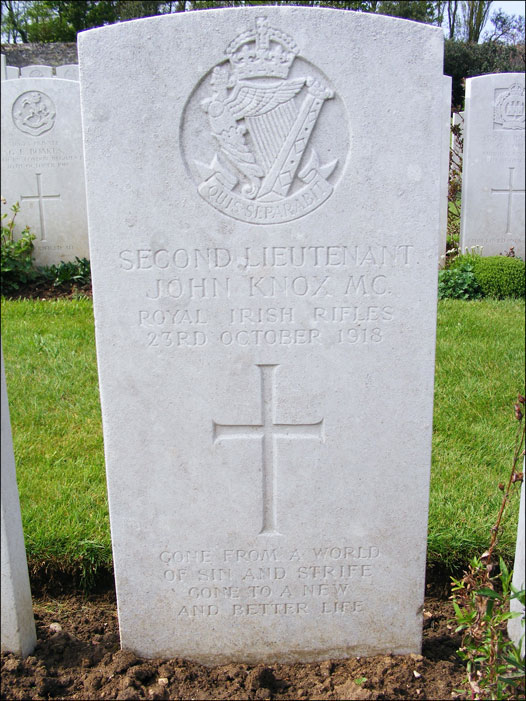![]() In memoriam
In memoriam ![]()
Second Lieutenant John Knox, MC & Bar

John Knox was born on 8 September 1886 at Tierkelly, Rathfriland, County Down, the third of four children of farmer Robert Knox and his wife Rebecca (nee Stewart).
He was educated at the Academical Institution, Banbridge, County Down and was then employed as a pharmaceutical chemist. On the outbreak of war he was working for Messrs S. Connor & Sons of Newry.
By the end of 1915 Knox was living in Edinburgh. He was attested into the army on 11 December 1915 and on 10 May the following year was mobilised and posted to the North Irish Horse at Antrim (No.2166).
On 7 December 1916, along with about 100 other North Irish Horsemen, Knox transferred to the Royal Irish Rifles (No.40887) and embarked for France. He joined the 1st Battalion in the field five days later and was posted to D Company.
Less than a fortnight later he applied for a commission in the infantry and on 2 January 1917 left for officer training in England. He reported for duty at No.20 Officer Cadet Battalion at Crookham, Hampshire, on 8 February.
On 30 May 1917 Knox was commissioned as a 2nd lieutenant and posted to the 13th (Service) Battalion, Royal Irish Rifles. Later that year he joined the battalion in France. At some point in the following months he transferred to the 15th (Service) Battalion, Royal Irish Rifles (the 13th Battalion was first merged with the 11th Battalion, then redesignated the 22nd Entrenching Battalion, then disbanded).
In January 1918 Knox was awarded a Military Cross. The records are not clear, but it appears to have been for his actions during the Battle of Cambrai. His citation was as follows:
For conspicuous gallantry and devotion to duty. In order to divert the enemy's attention from a main attack he was ordered to attack with one platoon a position strongly held with machine guns and protected by thick belts of wire. He led his platoon with great courage and skill, gaining his objective, and capturing the machine guns and forty prisoners before the main attack got level with him.
During 1918 Knox was hospitalised, rejoining his battalion on 30 May.
On 21 August an attack by the 15th Battalion in the Ypres sector advanced the line a quarter of a mile, capturing Mural and Wirral Farms. Knox was later awarded a Bar to his Military Cross for the way he handled his platoon in the attack. His citation stating:
For conspicuous gallantry during an attack. Having reached his final objective, he found the platoon on his right held up. He at once led an attack on the point, and captured it, taking a machine gun and six prisoners. Then he worked .along fences, clearing out three enemy posts, and established touch with the division on the right. He handled his platoon with the greatest skill, and showed fine courage and coolness under difficult conditions.
Four days later he left the battalion for a period of leave, during which he received his Military Cross from His Majesty the King at Buckingham Palace (on 26 September).
Knox returned to his battalion soon after and participated in the final push of the Advance to Victory Offensive. On 20 October 1918, as they pushed across Belgium, Knox received severe spinal and chest wounds. He was evacuated to the 8th Red Cross Hospital at Boulogne, but succumbed to his wounds on 23 October.
Second Lieutenant Knox was buried at Terlincthun British Cemetery, Wimille, Pas de Calais, France, grave VI.B.43. The gravestone inscription reads:
SECOND LIEUTENANT
JOHN KNOX MC
ROYAL IRISH RIFLES
23RD OCTOBER 1918
GONE FROM A WORLD
OF SIN AND STRIFE
GONE TO A NEW
AND BETTER LIFE

In the image above, Knox's grave is in the front row, fourth from the right.
Gravestone images kindly provided by Phil Watson. Image of 2nd Lieutenant Knox sourced from http://www.unionmasoniclodge23newry.co.uk/index.html.

